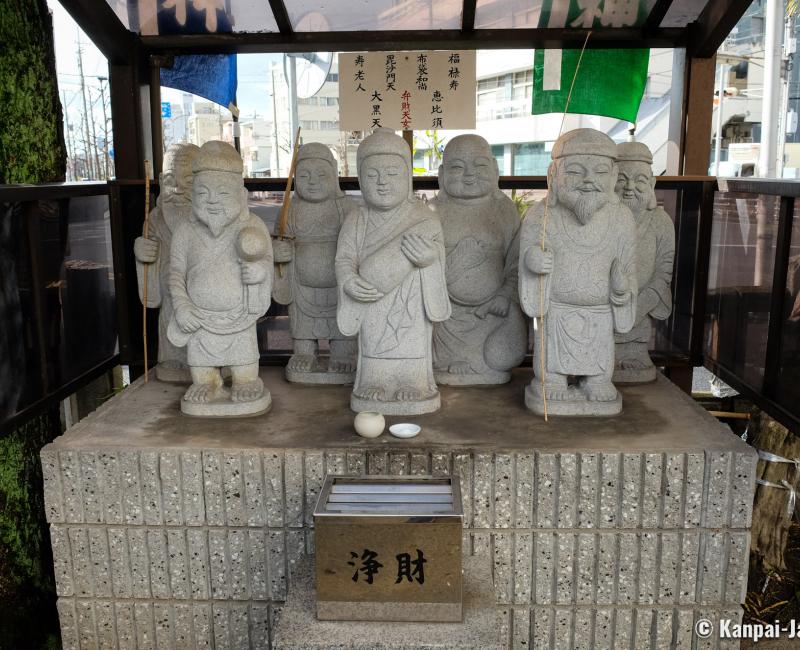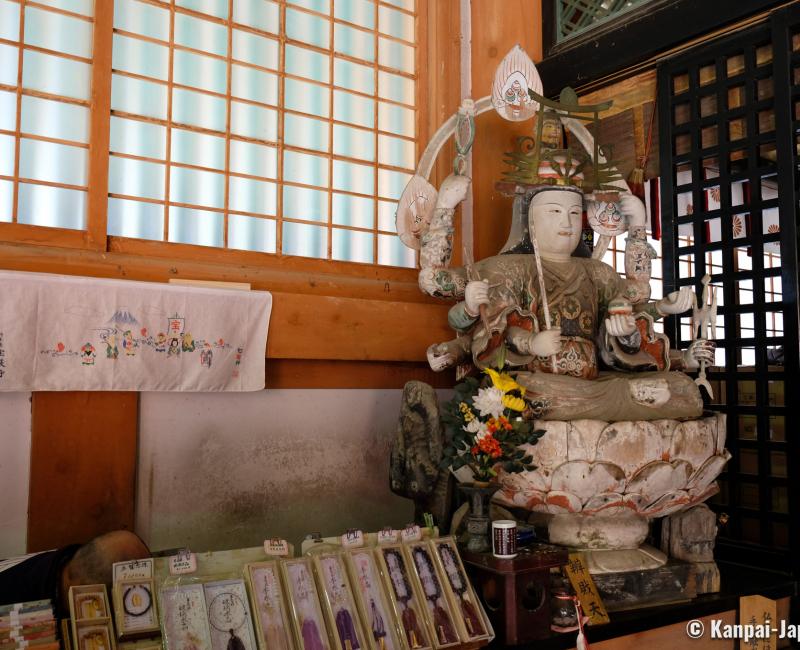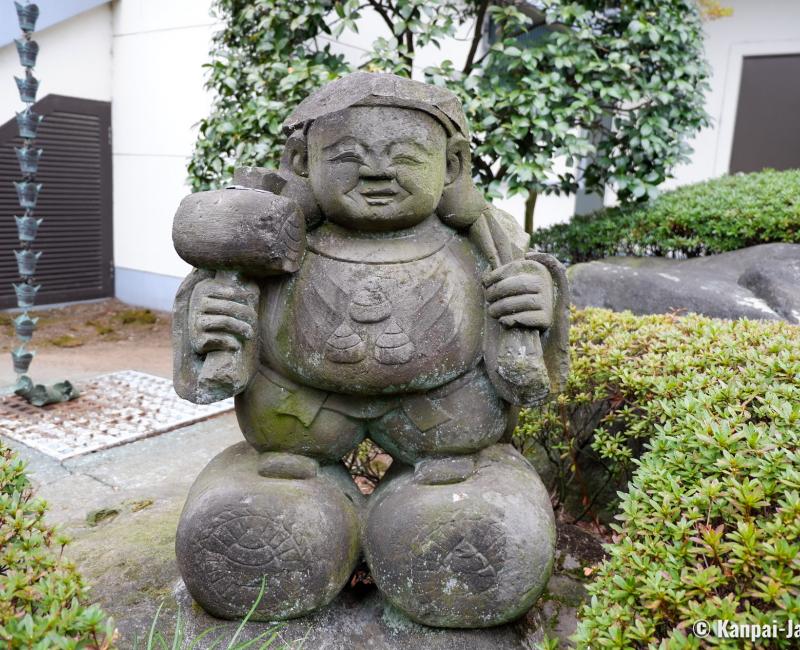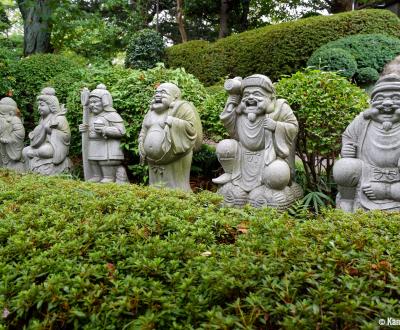The Seven Lucky Gods
Shichifukujin Gods in Japan
The Seven Gods of Fortune are named Shichifukujin in Japan where everybody knows Benzaiten, Bishamonten, Daikokuten, Ebisu, Fukurokuju, Hotei and Jurojin. People pray in the archipelago’s temples and shrines to be granted luck by this group of gods unique in the world and at the confluence of various religious currents.
In Japanese, the term 七福神 Shichifukujin describes the Seven Lucky Gods and is composed of:
- 七 shichi, the number 7, which is a lucky number,
- 福 fuku meaning "luck" or "good fortune"; and,
- 神 jin meaning "divine" or "god".
Benzaiten, Daikokuten, Ebisu, Bishamonten, Hotei, Fukurokuju and Jurojin are deities whose origins are found in Shinto, Buddhism, Hinduism, and Taoism. This unique blend of gods was permitted by Japan’s tendency towards religious syncretism. Together, they grant luck, happiness, and good fortune. Each trade is protected by one of the seven gods, that can also be prayed individually or as a group.
The importance of the Shichifukujin grew in the late Japanese Middle Ages, in a society that was eagerly looking for wealth. Some deities were included later, over times. The beliefs regarding the 7 current gods have been documented since the early 16th century in Japan.
Shichifukujin pilgrimage for a good start of the year
The 7 lucky gods have an important place in the daily rituals of the Japanese, especially during the New Year celebrations. The change of year is usually marked by the first ritual visit to the neighborhood’s shrine or temple, called hatsumode.
Those who would like to receive happiness and success for the next 12 months can instead make the Shichifukujin pilgrimage (七福神巡り Shichifukujin meguri in Japanese) that consists in visiting 7 temples and shrines in connection to each god in a limited area. Some itineraries can be well-trodden each early January such as in Kamakura, Kobe, Kyoto (there the pilgrimage is named 都七福神 Miyako Shichifukujin) or in Tokyo’s Minato and Ota (Ikegami district) wards.

Temples and shrines usually provide beautiful calligraphies, the goshuin stamps, to collect in a dedicated notebook, and with the Seven Lucky Gods pilgrimage it is also possible to collect each deity’s seal on a paper.
Another custom is for children to place under their pillow a traditional picture of the 7 godly characters in a ship named 宝船 Takarabune ("Treasure boat" in Japanese) during the night of January 1. By doing so, one makes sure that the first dream of the year, which is very important in Japan, will be a good omen and will bring luck to the next 365 days.
Representation of wealth and happiness in Japan
In Japanese mythology, the crew of 7 gods is pictured sailing on their boat and holding various traditional attributes that refer to:
- Wealth, with gold, fish and rice;
- Longevity, with symbolic animals such as the crane or the turtle;
- Prosperity, with replete bags and purses;
- As well as magical objects, such as an invisibility cloak or hat or a sacred key, that are used to grant the worshipers’ wishes.
Each god has its own attributes, a carriage, and a specific character so that they can be easily identified by everyone wherever the place they are enshrined. Let’s dive into a general introduction of the Seven Gods and their individual abilities.
🪕 Benzaiten (弁財天)
The goddess of arts, eloquence and knowledge is one of the most popular and the only female deity in the group. Protector of Japanese Buddhism and purveyor of wealth, Benzaiten or Benten is also a very powerful warrior.
Often linked to the water, she is frequently portrayed playing the biwa, a traditional string instrument, and sometimes with weapons when pictured with several pairs of arms.

⚔️ Bishamonten (毘沙門天)
God of war and good luck, Bishamonten originates from Hinduism and arrived in Japan via China. He is also known as Tamon-ten (多聞天) and is the most important of the Four Heavenly Kings, the Shi-Tenno guardians of the cardinal points in Buddhist temples. Gifted with an extremely developed hearing sense, he protects the world from demons by watching the north.
He is clad in a Chinese style armor and holds a spear, and is usually pictured carrying a miniature pagoda, as he is also a protector of the Buddhist teachings.
🎣 Ebisu (恵比須)
God of fishing, agriculture and trade, Ebisu is considered the only deity purely native of Japan among the 7 Shichifukujin, with Shinto origins.
In the Japanese society, fish and sea products are staple foods, so Ebisu is one of the most worshiped Lucky Gods in the archipelago. There is even an eponymous district in Tokyo, of which Ebisu is the symbol.
He is pictured with a fishing rod and a large fish in the hand, which is often a carp or a sea bream. His statue is often displayed in shops in Japan as he brings success in business. He is frequently associated to Daikokuten to whom he resembles.
🌾 Daikokuten (大黒天)
God of wealth, agriculture, and food purveyor, Daikokuten guarantees abundance and prosperity to the people. He is often associated with Ebisu, as they have similar functions. Of Indian origins, he also is a protector of the Buddhist laws.
He is pictured sitting on big bags full of rice, with a mallet that grants the believers’ wishes. In some shrines and temples in Japan, Daikokuten’s mallet is used to draw the omikuji papers that predict good or bad fortune. As he is a facilitator of commercial exchanges, his statue often decorates the shops counters or windows.

😊 Hotei (布袋)
The patron of economy, philanthropy, satisfaction and good health, Hotei is a semi-legendary Zen monk of Chinese Buddhism and is also documented in Taoism.
Carrying a large bag on the shoulders, he accumulates treasures to redistribute them to make people happy. According to some Zen theories however the bag is actually empty as a way to learn how to be content with what one already has. He is represented similarly to the Chinese Buddha, with a big and round bare belly (that one should stroke to attract luck) and an eternally smiling and gentle face.
🐢 Fukurokuju (福禄寿)
The deity of health and longevity, Fukurokuju originates from Taoism. He is pictured as a small elderly man with an over-sized forehead, a symbol of luck and immortality in Taoism. He is often sided with a crane or a turtle, animals that are characteristic of longevity in Japan.
Under his human form, he is said to be able to live without eating, and as a god he can resurrect the dead. He is often associated with Jurojin.
👴 Jurojin (寿老人)
Other Taoist god of longevity, Jurojin is also portrayed as an elderly man sided by a crane or a deer. He is holding a scroll or a sutra (a sacred text for Buddhist prayer) inscribed with the secrets of longevity and wisdom of the world. It is said that Fukurojin and Jurojin once shared the same body, hence the frequent confusion between these two gods.

